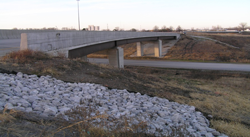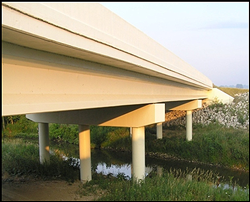Project Details
Ohio Department of Transportation
Researchers
Neal Hawkins
hawkins@iastate.edu email >Director Research Administration, ISU
About the research
This study was initiated by ODOT to evaluate the performance of four pavement marking materials (fast dry traffic paint, polyester, extruded thermoplastic and epoxy) in order to determine which materials are most suitable for the environmental and traffic conditions in ODOT District 11, which contains mostly rural roads with relatively low traffic levels (ADT less than 5,000 vehicles per day) and some areas of mountainous terrain.
The main focus of this study was to evaluate the performance of fast dry traffic paint and polyester as restriping materials; however, epoxy and thermoplastic were included in the evaluation for comparison purposes. The four materials were installed at 11 test sites distributed across the district on two-lane and four-lane highways having a variety of pavement types, pavement geometries, and traffic volumes. The performance of the pavement markings was evaluated in the field for a period of two years in terms of dry retroreflectivity, daytime color, and durability. Laboratory test procedures were also included to examine the quality of the glass beads used in this study. The field performance results were analyzed to determine the service life of the various marking materials. In addition, the results were used to estimate the life cycle cost of these materials and develop a material selection matrix for use in District 11.
Based on the outcome of this study, it was recommended that District 11 continue to use epoxy on new asphalt and concrete surfaces and to use traffic paint for restriping applications. For two-lane roads with asphalt surfaces, it was recommended to restripe the edge lines every two years and restripe the centerlines every year. On selected roads with sharp curves that slope towards the Ohio River, it was recommended to restripe the centerlines as well as the edge lines on an annual basis to avoid run-off road crashes. For multi-lane roads with asphalt surfaces, it was recommended to restripe locations with low traffic and good pavement condition every two years and restripe all lines at locations with high traffic (ADT greater than or equal to 10,000 vehicles per day) or rough pavement condition (pavement condition rating (PCR) less than 80) every year. For all roads with concrete surfaces, it was recommended to restripe all lines every year regardless of the traffic level and pavement condition. One material that is increasingly being used in Ohio for striping and restriping applications on asphalt surfaces is spray thermoplastic. This material was not included in this study because it is not compatible with epoxy, which was previously installed on several of the test sites prior to the beginning of this project. Some districts reported favorable results from using spray thermoplastic.
Therefore, District 11 is encouraged to look into using this less expensive material as an alternative for epoxy markings on new asphalt surfaces. It should be emphasized that the previous recommendations are specific to District 11 and may not be applicable to other ODOT districts due to variations in traffic levels, environmental conditions, and pavement marking material selection practices.
Project Details
05-202, TPF-5(100)
03/01/05
09/30/08
Connecticut Department of Transportation
Federal Highway Administration
Iowa Department of Transportation
Kansas Department of Transportation
New York State Department of Transportation
Ohio Department of Transportation
Slag Cement Association
Researchers
Scott Schlorholtz
Doug Hooton
About the research
The initial phase of this project was conducted to determine whether adding slag cement to concrete mixtures increases the surface scaling caused by the routine application of deicer salt. A total of 28 field sites that included portland cement concrete pavements and bridge decks containing slag cement were evaluated. Laboratory testing was conducted on 6 in. diameter core samples extracted from 12 field sites and 3 subsites, including 6 pavement sites and 6 bridge decks. The laboratory testing program consisted of scaling tests, rapid chloride permeability tests, surface chloride profile tests, and petrographic examination. The results of this study suggest that construction-related issues played a bigger role in the observed scaling performance than did the amount of slag in the concrete mixture.
Project Details
04/24/17
11/30/18
Federal Highway Administration State Planning and Research Funding
Ohio Department of Transportation
Researchers
Ashley Buss
About the research
Lack of funding and a desire to effectively manage the pavement network has resulted in the widespread use of chip seals by local agencies in Ohio. With the 2002 Construction and Materials Specifications (CMS), the Ohio Department of Transportation’s (ODOT) made major revisions to the chip seal specification to incorporate best practices applicable for pavements on the state highway system. However, the new specification may be burdensome and costly for local agencies to adopt due to lack of inspection personnel and a required level of quality which may not be necessary to achieve satisfactory performance on the local system. Many local agencies construct chip seals using local work crews and application rates based on experience, or with contractors using local specifications or older version of the ODOT specification. Consequently, success has been varied, with some excellent applications and some failures. The purpose of this research was to gain a better understanding of chip seal practices of the local agencies and identify best practices for low traffic volume roads. The goal of this research was to assess the current state of practice for chip sealing on county, township, and municipal-maintained roads. The objective was to develop a matrix of best practices for chip sealing low-volume roads in Ohio and design a study to aid in the future assessment of long-term performance creating protocols for data collection. As part of this study a literature review was completed, county and municipal engineers, and township trustees were surveyed regarding their chip seal practices, and follow-up interviews were conducted with eleven agencies. Based on the information collected a matrix of best practices for chip sealing on local roadways was developed and a study to collect long-term performance was designed. The best practices matrix identifies best practices as defined in the literature and by local agency personnel and is provided in this report. A plan and data collection software for a long term monitoring and evaluation of chip seals is also provided.
Project Details
04/30/15
01/30/19
Federal Highway Administration State Planning and Research Funding
Federal Highway Administration-Ohio Division
Ohio Department of Transportation
Researchers
About the research
With the ongoing concern about premature cracking of concrete bridge decks that reduces the service life of bridges and results in increased maintenance and replacement costs, this work aimed at assessing the benefits of using lightweight fine aggregate (LWFA) in concrete mixtures to assist the Ohio Department of Transportation (ODOT) in preparing a specification to increase the probability of achieving crack-free, long-lasting bridge decks. A laboratory testing program led to a recommended mix design for implementation on a bridge construction project in Ohio. The design included the use of 50% slag cement and LWFA for internal curing. Construction of two bridge decks involved a control using a conventional mix design and the other containing the recommended mixture. The decks were instrumented and load tested shortly after construction and inspected one year after placement. No differences in structural performance were noted, but there were far fewer cracks in the test deck compared to the control. A life-cycle cost analysis was also conducted and shown that the premium for the recommended mixture would be recovered in reduced maintenance over the life of the bridge.
Project Details
08-323, TPF(5)169
06/01/08
01/01/14
Federal Highway Administration Transportation Pooled Fund
Iowa Department of Transportation
Ohio Department of Transportation
Pennsylvania Department of Transportation
Wisconsin Department of Transportation
Researchers
About the research
Nationally, there is concern regarding the design, fabrication, and erection of horizontally-curved steel girder bridges due to unpredicted girder displacements, fit-up, and locked-in stresses. One reason for the concerns is that up to one-quarter of steel girder bridges are being designed with horizontal curvature. The concerns are significant enough that a National Cooperative Highway Research Program (NCHRP) research problem statement was developed and given high priority for funding.
It is also noted that an urgent need exists to reduce bridge maintenance costs by eliminating or reducing deck joints. This can be achieved by expanding the use of integral abutments to include curved girder bridges.
The long-term objective of this effort is to establish guidelines for the use of integral abutments with curved girder bridges. The primary objective of this work was to monitor and evaluate the behavior of six in-service, horizontally-curved, steel-girder bridges with integral and semi-integral abutments. In addition, the influence and behavior of fixed and expansion piers were considered.
Project Details
08/07/08
01/31/11
Ohio Department of Transportation
Researchers
Jake Bigelow
David White
About the research
Bridge owners have long recognized that the approach pavement at bridges is prone to exhibiting both settlement and cracking, which manifest as the “bump at the end of the bridge.” This deterioration requires considerable on-going maintenance expenditures, added risk to maintenance workers, increased distraction to drivers, reduced steering control, increased damage to vehicles, a negative public perception of the highway system, and a shortened useful bridge life. This problem has recently begun to receive significant national attention, as bridge owners have increased the priority of dealing with this recurring problem. No single factor, in and of itself (individually), leads to significant problems. Rather, it is an interaction between multiple factors that typically leads to problematic conditions. As such, solutions to the problem require interdisciplinary thinking and implementation. The bridge-abutment interface is a highly-complex region and an effective “bump at the end of the bridge” solution must address the structural, geotechnical, hydraulic, and construction engineering disciplines. Various design alternatives, construction practices, and maintenance methods exist to minimize bridge approach settlement, but each has its own drawbacks, such as cost, limited effectiveness, or inconvenience to the public.
The objective of this work is to assist the Ohio Department of Transportation in the development of pre-construction, construction, and post-construction strategies that will help eliminate or minimize the “bump at the end of the bridge.” Implementation of the details and procedures described herein will provide a tangible benefit to both the Ohio Department of Transportation and the traveling public, in the form of smoother bridge transitions, reduced maintenance costs, and a safer driving environment.
As a result of this work, several conclusions and recommendations were made. Generally, these could be grouped into three categories: general, structural, and geotechnical. In some cases, the recommendations may require notable changes to the Ohio Department of Transportation bridge design policy. Suggestions for such changes have been made.
Project Details
02/01/03
12/01/07
American Concrete Pavement Association
Concrete paving industry
Federal Highway Administration
Georgia Department of Transportation
Indiana Department of Transportation
Iowa Department of Transportation
Kansas Department of Transportation
Lousiana Department of Transportation
Michigan Department of Transportation
Minnesota Department of Transportation
Nebraska Department of Roads
New York State Department of Transportation
North Carolina Department of Transportation
North Dakota Department of Transportation
Ohio Department of Transportation
Oklahoma Department of Transportation
South Dakota Department of Transportation
Texas Department of Transportation
Wisconsin Department of Transportation
Researchers
Jim Grove
Fatih Bektas
About the research
The objectives of this five-year Transportation Pooled Fund study are to evaluate conventional and new technologies and procedures for testing concrete and concrete materials to prevent material and construction problems that could lead to premature concrete pavement distress, and to develop a suite of tests that provides a comprehensive method of ensuring long-term pavement performance. A preliminary suite of tests to ensure long-term pavement performance has been developed. Shadow construction projects are being conducted to evaluate the preliminary suite of tests. A mobile concrete testing laboratory has been designed and equipped to facilitate the shadow projects. The results of the project are being compiled in a user-friendly field manual, which will be available by summer 2006.







